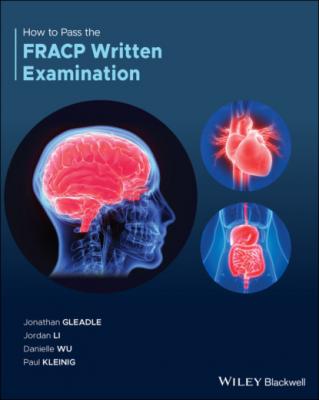How to Pass the FRACP Written Examination. Jonathan Gleadle
Читать онлайн.| Название | How to Pass the FRACP Written Examination |
|---|---|
| Автор произведения | Jonathan Gleadle |
| Жанр | Медицина |
| Серия | |
| Издательство | Медицина |
| Год выпуска | 0 |
| isbn | 9781119599548 |
Streptococci and staphylococci account for 80% of cases of IE, with proportions varying according to valve (native vs prosthetic), source of infection, patient age, and coexisting conditions. Staphylococci are now the most common cause of IE and approximately 35%–60.5% of staphylococcal bacteraemia are complicated by IE.
Cases of IE in which a blood culture is negative (10% of cases) may be due to patients exposed to antibiotic agents before the diagnosis of IE or IE caused by fastidious microorganisms.
Cerebral complications are the most frequent and most severe extracardiac complications. Vegetations that are large, mobile, or in the mitral position and IE due to Staphylococcus aureus are associated with an increased risk of symptomatic embolism.
IE remains a diagnostic and therapeutic challenge. Identifying the causative microorganism is central to diagnosis and appropriate treatment; two or three blood cultures should routinely be drawn before antibiotic therapy is initiated. When IE is suspected, echocardiogram should be performed as soon as possible. However, the diagnosis of IE can never be excluded on the basis of negative echocardiogram findings, either from transthoracic echocardiogram or transesophageal echocardiogram.
Appropriate antibiotic treatment of IE is guided by Australian Therapeutic Antibiotic Guidelines. Approximately 15%–25% of patients with IE eventually require surgery. Indications for surgical intervention in patients with native valve IE are as follows:
Congestive heart failure that is refractory to standard medical therapy
Fungal infective endocarditis
Persistent sepsis after 72 hours of appropriate antibiotic treatment
Recurrent septic emboli, especially after 2 weeks of antibiotic treatment
Rupture of an aneurysm of the sinus of Valsalva
Conduction disturbances caused by a septal abscess
Kissing infection of the anterior mitral leaflet in patients with IE of the aortic valve.
Hoen B, Duval X. Infective Endocarditis. New England Journal of Medicine. 2013;368(15):1425–1433.
https://www.ncbi.nlm.nih.gov/pubmed/23574121
15. Answer: C
According to the ACC/AHA guideline, a biventricular pacemaker and defibrillator should be offered to patients with NYHA class III or IV heart failure, an ejection fraction <35% and a QRS complex >0.12 second. Approximately 70% of patients' symptoms improve due to resynchronisation of the timing of the left and right ventricular contraction. Device treatment has been shown to improve mortality, ejection fraction, quality of life, and functional status, as well as reduce readmission.
A dual‐chamber pacemaker does not provide symptomatic relief or protect patients from ventricular arrhythmias and sudden cardiac death. Recent clinical trials have demonstrated SGLT2 inhibitors reduces mortality and hospitalisation in patients with type 2 diabetes and established cardiovascular disease. However, it is currently contraindicated in patients with eGFR <30 ml/min/1.73 m2. Adding a beta blocker in an elderly patient with severe airway disease and insulin dependent diabetes may need careful consideration and is not the most effective treatment for this patient.
Normand C, Linde C, Singh J, Dickstein K.Ref: Indications for Cardiac Resynchronization Therapy. A Comparison of the Major International Guidelines JACC: Heart Failure. 2018;6(Issue 4):308‐316., April 2018
https://www.sciencedirect.com/science/article/pii/S2213177918301203
16. Answer: C
SGLT2 inhibitor (SGLT2i) works by inhibiting SGLT2 in the proximal convoluted tubule, to prevent reabsorption of glucose and facilitate its excretion in urine. As glucose is excreted in urine, its plasma levels fall leading to an improvement in glycaemic parameters. This mechanism of action of SGLT2i is dependent on blood glucose levels and has minimal potential for hypoglycaemia. SGLT2i's mode of action depends upon normal renal glomerular–tubular function and their efficacy is reduced in persons with renal impairment. SGLT2i are not prescribed on their own but can be used in combination with other diabetes medications. SGLT2i may also cause modest weight loss and reduce systolic blood pressure, which are beneficial for patients with heart failure.
Thiazolidinediones may cause water retention, weight gain, or worsen heart failure and are contraindicated in patients with New York Heart Association (NYHA) class II–IV heart failure. They should be used cautiously in patients with NYHA class I heart failure.
Atherton J, Sindone A, De Pasquale C, et al. National Heart Foundation of Australia and Cardiac Society of Australia and New Zealand: Australian clinical guidelines for the management of heart failure 2018. Medical Journal of Australia. 2018;209(8):363–369.
https://onlinelibrary.wiley.com/doi/abs/10.5694/mja18.00647?sid=nlm%3Apubmed
17. Answer: B
This patient's clinical presentation, risk factors, and echocardiogram findings are consistent with heart failure with preserved ejection fraction (HFpEF). No therapy has been proven to reduce mortality in patients with HFpEF.
HFpEF predominantly affects elderly (>65 years) hypertensive women. Other risk factors include obesity, coronary artery disease, diabetes, atrial fibrillation, and hyperlipidaemia. It is established that the prevalence of HFpEF among patients with heart failure averages 47% and its prevalence in the community is estimated to be 1.1% to 5.5% of the general population. The prevalence of HFpEF has increased over the last two decades, due to ageing population, increasing prevalence of risk factors, such as hypertension, diabetes, and increased survival.
The diagnosis of HFpEF can be challenging because the symptoms and signs are non‐specific, hence it is a strictly clinical diagnosis. For patients presenting with heart failure and relatively normal LV ejection fraction (LVEF), valvular heart disease, infiltrative cardiomyopathies, pericardial disease, high‐output heart failure, chronic pulmonary disease, and pulmonary arterial hypertension should be excluded. An elevated BNP or NT‐proBNP on its own is insufficient for the diagnosis or exclusion of HFpEF.
Echocardiogram is the imaging modality of choice to establish the diagnosis of HFpEF by criteria; exclude valvular, right‐sided, or pericardial disease; and assess for other differential diagnoses. The following are the echocardiographic criteria recommended by the European Society of Cardiology for the diagnosis of HFpEF:
LVEF ≥50%
LV end‐diastolic volume index (LVEDI) <97 mL/m2
Raised LV filling pressure is indicated by a ratio of mitral early diastolic inflow velocity to mitral early annular lengthening velocity (E/e')>15.
Cardiac
